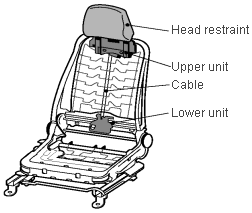Jul. 03, 2007
Toyota Develops Advanced Head Restraint to Help Reduce
Intensity of Whiplash Injuries
Tokyo ― TOYOTA MOTOR CORPORATION (TMC) announced today that it has developed the Active Headrest, a new head restraint that reduces the stress on the neck during low-speed, rear impacts. TMC plans to introduce the head restraint shortly, starting with new vehicle models.
At Toyota, the utmost importance is placed on improving vehicle safety through the analysis of accidents, and this approach has led to advances in passive safety technologies, such as the concept of omni-directional compatibility, pedestrian injury-lessening vehicle bodies and front seats based on the WIL (Whiplash Injury Lessening) concept. The Active Headrest has been developed to reduce the risk of whiplash injuries sustained during rear-end collision.
Active Headrest System

The lower unit built into the seatback recognizes when the occupant's lower back presses against the seatback; it then triggers the upper unit, via a cable, to activate the head restraint.
Active Headrest

By moving diagonally upward (30mm up and 25mm forward), the head restraint quickly and securely catches the back of the head.
The Active Headrest is an extension of the WIL concept seat, in which both the seatback and head restraint simultaneously cushion the head and lower back to reduce stress on the neck. Specifically, when the occupant's back presses against the seatback during a rear-end collision, a built-in lower unit triggers the head restraint to move diagonally upward. This action swiftly and securely catches the back of the occupant's head, thereby reducing the risk of whiplash injury sustained by the neck upon collision (results will differ according to the physique, position and posture of the occupant inside the vehicle; however, in-house testing of the Active Headrest showed that it reduced the severity of whiplash injury by 10-20% on Toyota's neck injury evaluation index compared with the traditional WIL concept seat).
As part of its efforts to realize sustainable mobility, Toyota intends to strengthen its traffic safety initiatives in the future through: 1) the development of even safer vehicles and technologies, 2) participation in the creation of a safe traffic environment and 3) activities designed to educate people in traffic safety, thereby contributing to the complete elimination of traffic casualties, which can be viewed as the ultimate hope of a society that values mobility.






